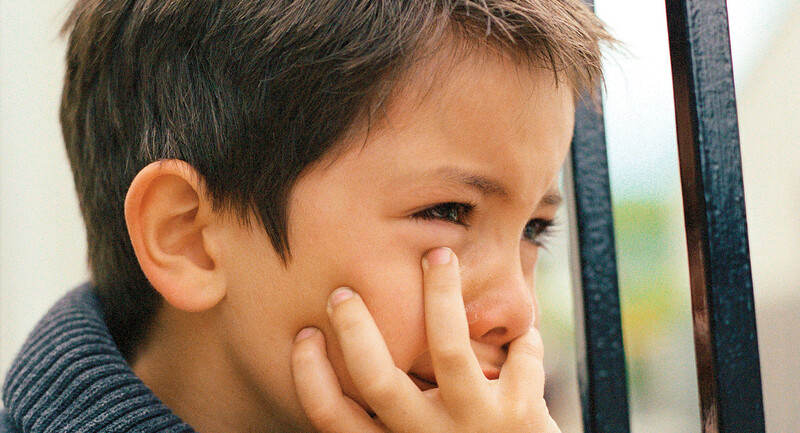The note Rebecca left on my desk after I left school one afternoon said simply, "I wanted you to know I won't be in class tomorrow. I thought you might worry." The next morning, I'd just arrived at school and had the note in my hand when a policeman came to our classroom door.
Rebecca was one of several students who taught me about childhood trauma and the weight its victims carry with them to school. The concept of trauma-informed schools and classrooms is relatively new. Trauma is not. It's frightening to consider that nearly half of students who come to us daily have experienced at least one traumatic event or adverse childhood experience. Twenty-two percent have experienced two or more such experiences, and 35 percent have had at least one traumatic experience before they enter kindergarten. Those are facts. The personal realities are more stunning—and humbling.
The realities I encountered in my years of teaching all had names, faces, personalities, and hopes muddled with fears. They came to school from low-income neighborhoods and affluent ones. They spanned cultures, languages, and countries of origin. The traumas they experienced included abuse, economic deprivation, learning disabilities, war-related incidents, bullying, the death of a parent, and struggles with sexual orientation. Those are the stressors I knew existed and could label. There were doubtless others my students faced that never surfaced but were no less real and damaging.
As always, my students taught me important lessons—lessons about teaching in the midst of overt and covert trauma. Insights I gleaned from them include:
- Trauma is not a single thing, but a constellation of symptoms and challenges of varying duration and intensity, stemming from an array of experiences. Trauma manifests on a continuum from almost complete withdrawal to atomic explosion. There isn't a recipe for working with students who have experienced trauma. (There is a foundational principle, however, which I'll get to later.)
- I can't always figure out how to make things better. But if I'm on my game, I should be able to figure out how not to make them worse.
- There are almost always people around who are more experienced in working with students facing trauma than I am. They may include last year's teacher, the teacher who is with the student the period before my class, a counselor, school social worker, or parent. The category of people who will most likely be helpful varies with the individual student, but in general, I'll be more helpful to any student if I don't try to go it alone.
Students' Stories
I believe humans make sense of our lives by telling stories. Following are four abbreviated versions of longer stories that played out in classrooms I worked in and became etched in my memory. They reflect experiences with four very different young people who were trying their darndest to create sense and order in their worlds. The lessons I drew from them became guides for trying to make things better for the students I taught next.
What Franklin Taught Me About Triggers
Franklin was four and restless, hovering most of the day between anxious and angry. The adults in the preschool he attended were watchful of Franklin as we tried to befriend him and make the space we shared feel safe to him. His explosions were mighty and unpredictable.
One afternoon about three months into the year, I was reading a story to the children as they sat at tables in the classroom. At one point, I got up from my storyteller stool and began walking around the room, continuing the story with different voices for different characters and a little drama in my movements. Franklin usually liked stories best of all and often stood up and acted out what I was saying while I walked among the kids. I paused briefly behind his chair, resting my hand on the back of it as I spoke, and then moved on. Suddenly there was dreadful screaming. Franklin ran frantically around the perimeter of the room, arms flailing. While this behavior was not new to his classmates, they became big-eyed and frozen in place.
I said gently, but with some force, "Franklin, come with me for a minute. We need a break." We walked around the outdoor play area in silence for a few minutes. After a bit, he reached out for my hand. "Want to sit on the bench together?" I asked. We did that for a bit, then he took my hand again and led me back to the classroom where my teaching assistant was singing silly songs with the children.
We moved from the songs into a free-choice activity time. I moved around the room, asking the children questions about their work, feeling a need to be near each one with a tone that might reassure them. Marcia, who was seated at the table with Franklin when he exploded, was the second student I sat beside. Before I could say anything to her, she made eye contact with me, tilted her head, and said, "Ms. T, you shoulda figured out by now, ya can't sneak up on Franklin!"
I could argue that I was very inexperienced in teaching and in life, which was true. But Marcia, at 4 years old, had realized something very basic that I had not. Franklin responded to predictable triggers. I was the adult and should've known to look for and avoid those triggering moments. On that day, I didn't know to do that. After that day, I did!
Teaching Eli to Read
Eli was 15 years old when he came into my class two weeks into the term, having whispered to me on the way into the room that he could not read. He was smaller than the 12-year-olds who already felt at home in my classroom. His voice barely made sounds. But I learned more about teaching from my year with Eli than from all the courses I've taken and all the reading I've done on education.
Despite having no idea how to teach reading, I was determined not to betray the courage it took for Eli to make his confession to me as he entered a wholly strange place. He was the child of migrant workers. Eli's parents cared deeply about him, but his childhood was marked by instability, deprivation, and spare acquaintance with the larger world. I worked with him one-on-one every chance I could create. I prepared work just for him, recorded stories (so he could listen to each recording while he looked at the same story in print, making word connections), and asked other students to record as well. I used colorful pictures to teach concepts and to spark ideas and stories of his own. I gave him careful feedback and checked to make sure he understood it. Always, I was nagged with one question: "How can I make time for Eli when there are 38 other students waiting for me?"
I met Eli in my third year of teaching. From my own student life, my image of a teacher was someone who stood in front of the class and talked to the group as though they were a single individual. Of course, my students spent time doing things other than listening—reading, writing, working with vocabulary, and so on. Those times seemed to me to be opportunities to give my full attention to Eli while his classmates were "gainfully employed." Somehow, though, that never panned out. Working "independently," whether in small groups or alone, seemed to generate an unceasing gush of questions that needed my attention.
One day about midway through the year, two things happened that ignited an insight that should have been embarrassingly evident to me for months. First, a boy who sat near Eli pointed to some work Eli was doing and asked if he could do it, too, adding, "I think I could do that." In the same class period, I noticed another student reading a book that I struggled with in college. He'd finished the work required of him and chosen to do something that was evidently a closer match to his needs than what I had prepared for the class.
At that moment, I understood that I didn't have a class of 39 that could be divided into the "normal" kids and Eli. I had a class in which everyone needed me in different ways. The "normal" lesson was varying degrees of too demanding for many students, too redundant for many others, and probably relatively boring to all of them.
That realization turned my idea of teaching inside-out. I couldn't make the class work for Eli unless I could make it work for each student. The idea of a "typical" or grade-level learner was fiction; I had to get on-board with that. That day began what has been a nearly 50-year quest to understand ways to make teaching and learning flexible enough for a teacher to reach any student on almost any day, as students work in a range of configurations and with varied resources, to help each one—including those for whom trauma is a barrier to learning—learn on their own terms.
Reaching a "Lost" 8th Grader
The day before Lucas was scheduled to start school with me as his 8th grade teacher, his mother came to see me. She told me about a boy who was creative, innovative, and a neighborhood leader, even of older children. Every summer, Lucas made up plays, gave neighborhood kids roles he thought suited them, and directed his peers in learning and performing their roles. The kids put on the plays with costumes, sets, and props on summer nights under the streetlights, with parents and younger children as the audience. Lucas was the director writ large. His mom talked about his joy in learning and teaching during those early years. Then she stopped abruptly and, trying to hold back tears, said, "If things don't get better, we'll lose him this year."
She was clearly anguished. I interpreted her message to indicate that Lucas was ill and would likely die during his 8th grade year. I couldn't find any words and couldn't begin to imagine how I would help Lucas and the other students I hadn't yet met go down that road together. When Lucas's mother found her voice again, she explained that Lucas had a severe learning disability that made it virtually impossible for him to spell even the simplest words correctly. "For all his years in school," she said, "the almost singular goal of his teachers has been to teach him to spell. He has failed so often over so many years that he has lost all his joy. He sees himself as hopeless—worthless. He needs someone who will encourage him to work with his strengths and who will give up on fixing what's broken." She paused again and said, "He's almost gone now. If he has another year of failure, he'll be lost."
Still young and uncertain of myself and my teaching, I had two thoughts in rapid succession: "Do teachers get fired if they refuse to make a kid do spelling exercises?" and "I think I'm getting ready to find out."
Trauma often accompanies long struggles with disabilities. I worked to let Lucas know I cared about him and saw what was whole in him. When he worked in groups, I made sure he was never the scribe. When other kids worked with spelling, Lucas had options for creating stories and incorporating advanced vocabulary into them, drawing cartoons that illustrated challenging vocabulary we were studying in class, or other word-related work he suggested.
By the end of the year, Lucas looked up more often than he looked at the floor. He was finding his voice again. The lesson I learned from Lucas and his mother has served me well. No academic goal is worth the soul of a child.
Down the road, Lucas earned a master's degree. I suppose spellcheck, which didn't exist during the days when Lucas was in middle school, helped him circumvent his learning disability. I didn't get fired and have, with more courage, applied the lesson I learned that year in subsequent years of teaching.
The Note from Rebecca
As I stood at my desk, my tote bag still in my hand, I looked at Rebecca's note (which told me only that she wouldn't be in class that day) with confusion and fear. When I looked up and saw the policeman in the door, the room turned cold.
Rebecca was the kind of student we'd all like to duplicate. She did consistently good work. She was attentive in a way that was encouraging, often nodding when I'd make a point or share an illustration with the class. She was more mature than her age would suggest, pitching in with any task that needed doing and always attentive to the moods and needs of other students in the class.
Over the three days prior to Rebecca's note, we had been working with the thing I least liked teaching—parts of speech. Not only did students groan when we revisited grammar in a learning cycle, but I couldn't see any use in teaching it as we were expected to—from a grammar book and out of context. I might have let it slide, but the teacher who would inherit my students the following year valued grammar proficiency above all other things. I didn't want to set the kids up for failure and disdain.
Rebecca was in my last class of the day. By that hour, my energy was waning. The students' tanks were low, too. I'd worked hard to create things we could do with the prepositions and conjunctions that were at least lively if not life-shaping. Rebecca always seemed to know when I was trying hard and would nod approvingly in my direction as I spoke. But on those three days, she hadn't even looked in my direction. I interpreted that as a sign of failing in my mission and maybe even felt a little peeved with her because she wasn't playing her usual role.
The policeman asked if I knew who Rebecca ate lunch with so he could start talking to some of her friends. I didn't. But in that instant, I saw that I absolutely needed to know these young adolescents in a far more multidimensional way.
It came out that Rebecca had run away from home. Her mother was in the hospital, terminally ill; her father was abusing her nightly. She couldn't leave because she knew that if she did, her younger sister, for whom she was becoming a surrogate mother, would be next in line. And then, she just couldn't stay any longer.
I knew none of these things until the policeman shared them with me. I should have known more than I did—or should at least have been more watchful than I was. Rebecca spent some time with a foster family before she came back to school. On her return, she looked afraid but resumed her place in the group and generally played the role she had played before she left. I found her in the hall one day, bent over and in tears. She had just learned by chance that her mother had died in the hospital several days before; her father, with whom she had not communicated since she ran away, hadn't seen fit to tell her. Trauma is often more of a life pattern than an event.
I gained three insights from my experience with Rebecca:
- To help kids grow, you have to know them as far more than grades and attendance records. When you really need to reach a kid, those indicators are nearly worthless.
- Don't ever assume a student's behavior is about you. As long as that's your frame, a student's worth is somehow an indicator of your own.
- No kid's worth is tied up in grammar lessons, algebraic formulas, or any other content knowledge. Kids need to know that.
The Biggest Lesson: Empathy
In the years that I taught these students, I didn't think of them as kids who struggled with trauma. I don't think that word ever came to mind as I tried to help them find some semblance of safety, voice, and accomplishment. I would have been so relieved to find books written about young people with struggles like the ones described here. It would've been a boon to have professional development sessions on supporting students whose lives are shaped by adverse childhood experiences.
Short of those resources, I learned from my students. Here's the most powerful lesson I took from them: Empathy is a great healer. To the degree that we were able, together, to take steps forward, empathy was the reason. I take empathy to mean seeking to understand a person's experience, condition, and needs with the aim of making a difference by responding to those needs. On days when I could live and teach inside that frame, I could often (though not always) make a difference to kids whose lives were so unfairly scarred. And I could make a difference in the lives of their classmates, because it's never easy to grow up—even for kids who aren't facing trauma.
And the young people whose lives were hardest, like those profiled here, were the most able to teach me this.
Author's note: All student names are pseudonyms.









